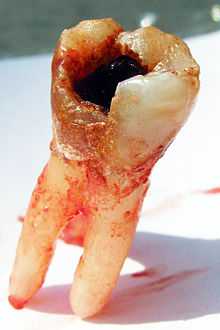Dental disease
Dental diseases may affect the teeth, the gums, or other tissues and parts of the mouth. Dental diseases can cause much more serious problems than toothache; they can affect our ability to chew, smile, or speak properly.[1]
These are among the most common diseases in humans [2] and include dental caries, gingivitis, periodontitis and many more oral conditions. The prevention, diagnosis, treatment and rehabilitation of these diseases are the base to the dentistry profession, in which are dentists and dental hygienists, and its sub-specialties, such as oral medicine, oral and maxillofacial surgery, and endodontics.
Dental diseases may also affect the gums. Dental disea> ses can cause a range of problems from a slight tooth ache, to cavities, and ulcers. The three most common of these diseases are Dental Caries, Gingivitis, and Periodontitis. These diseases can affect speech, smile, ability to chew, and in some cases the loss of teeth. Dental Diseases can be prevented by taking proper care of teeth. Brushing, flossing, and regular visits to the dentist will help prevent these diseases.
Dental caries

Dental caries are known as a cavity or tooth decay. Bacteria in the mouth use foods that contain sugar or starch to produce acids which eat away at the tooth’s structure causing destruction to the enamel of the teeth. Meanwhile, the minerals in saliva (calcium and phosphate) together with fluoride are repairing the enamel.[3] Dental caries are a chronic disease that can be prevented and show strongly in 6 to 11 year old children and 12 to 19 year old adolescents. 9 out of 10 adults are affected with some type of tooth decay. Prevention includes good oral hygiene that consists of brushing twice daily, flossing, eating nutritious meals and limiting snacking, and visiting the dentist on a regular basis. Fluoride treatments benefit the teeth by strengthening while sealants help chewing surfaces to not decay.[4] Severe cases can lead to tooth extraction and dentures.
Abscesses
A dental abscess is a collection of pus that accumulates in teeth or gums as a result of bacterial infection giving rise to a severe throbbing pain at the site of the abscess. It is caused by consuming sugary or starchy food and poor dental hygiene and is treated by a dentist draining the pus and possibly removing an infected tooth.[5]
Gingivitis
A common periodontal (gum) disease is Gingivitis. Periodontal refers to the area the infection affects, which include the teeth, gums, and tissues surrounding the teeth. Bacteria cause inflammation of the gums which become red, swollen and can bleed easily. The bacteria along with mucus form a sticky colorless substance called plaque which harbours the bacteria. Plaque that is not removed by brushing and flossing hardens to form tartar that brushing doesn't clean. Smoking is a major risk factor.[6] Treatment of gingivitis is dependent on how severe and how far the disease has progressed. If the disease is not too severe it is possible to treat it with chlorhexidine rinse and brushing with fluoride toothpaste to kill the bacteria and remove the plaque, but once the infection has progressed antibiotics may be needed to kill the bacteria.[7]
Periodontitis

When gingivitis is not treated it can advance to periodontitis, when the gums pull away from the teeth and form pockets that harbour the bacteria. Bacterial toxins and the body's natural defences start to break down the bone and connective tissues. The tooth may eventually become loose and have to be removed.
Other conditions
Related conditions include burning mouth syndrome, bad breath, oral cancer, oral or facial pain, taste disorder, TMJ disorder and dry mouth.
See also
- Oral medicine
- Oral pathology
- Tongue disease
References
- ↑ "Dental Diseases and Dental Health Problems". DentalDiseases.org. Retrieved 2011-11-11.
- ↑ "Cavities/tooth decay". Mayo Clinic. Retrieved 2013-12-30.
- ↑ "The Tooth Decay Process: How to Reverse It and Avoid a Cavity". National Institute of Dental and Craniofacial Research. Retrieved 2013-12-27.
- ↑ "Water-related Hygiene". Centers for Disease Control and Prevention. Retrieved 2013-12-25.
- ↑ "Dental abscess". NHS Choices. Retrieved 2013-12-30.
- ↑ "Periodontal (Gum) Disease: Causes, Symptoms, and Treatments". National Institute of Dental and Craniofacial Research. Retrieved 2013-12-27.
- ↑ "Gingivitis". Emedicine. Retrieved 2013-12-25.
External links
- "10 dental myths exploded". NHS Choices. Retrieved 2013-12-30.
- "Oral Health". National Institute of Dental and Craniofacial Research. Retrieved 2013-12-30.